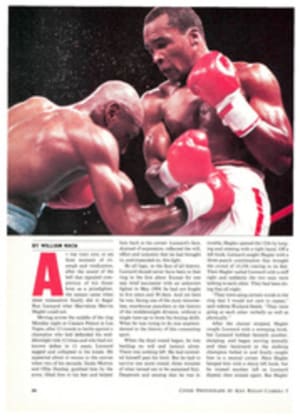
A LETTER FROM ONE WHO KNOWS
DEAR DWIGHT GOODEN FANS,
He is in the right place. I know, because I've been there. Smithers is one of the top rehabilitation centers in the country. Still, there are no guarantees that Gooden will be able to kick his drug habit any more than there are guarantees that I'll be able to kick my liquor habit. As patients are reminded over and over, "Look at the person on your right, look at the person on your left. One of them isn't going to make it." But fifty-fifty is better than no odds at all. Making it depends on how hard each of us works in the program, and that depends entirely on accepting addiction—and accepting ourselves. If he doesn't think he has a problem, or that he can control it, he won't make it.
I checked into Smithers last November for the center's 28-day treatment program. When it came time to leave, I had bittersweet feelings. I couldn't wait to get out of the damn place, into the fresh air and away from the smell of mashed potatoes. But then I also wanted to stay a little longer, safely propped up by the staff and the other patients, secure from the world outside. I had grown accustomed to the daily routine and to living in that grand house on Manhattan's Upper East Side, the Billy Rose mansion, which since 1973 has been a home for alcoholics and drug addicts. They move through at the rate of 500 a year.
I was shown around my first day by Jose, my roommate and a superintendent with the postal service. He came down to the lobby to greet me, stood by while my bag was searched (no shaving lotion—it's high proof). Meeting the other patients is a bit like the first day in school or in the service, but eventually you make friends regardless of background or chemical of choice. I'm making up the names here, but I took a liking to Vinnie, a truck driver and alcoholic; Achmet, an artist and heroin addict; Terry, a gangster and cocaine addict; Floyd, a 64-year-old entrepreneur and alcoholic; and Doris, a motherly type addicted to gin.
The daily schedule is pretty grueling: breakfast at 7:30 and then a long day of group-therapy sessions and hour-long lectures until supper at 5:30. The 90 most brutal minutes of the Smithers treatment come in the morning group-therapy session. Newcomers are invited to tell how they came to Smithers. Most describe the good parts first, but then the more seasoned group members pounce on the holes in the story, trying to bring out the miseries we all went through. Sooner or later, almost every patient tells the truth, breaks down and cries. I did.
There are no hard statistics on who leaves Smithers and stays sober or drug-free. For one thing, such statistics mean nothing. We are never cured, but always in recovery, one day at a time. Several members of my group are back out there, back on booze, back on crack. My first weekend home, I called my roommate Jose, who had left Smithers two weeks after my arrival. His wife, whom I had met on one of the visiting days with their four young children, said that Jose was long gone.
Some of us have made it longer. I'm in touch with Vinnie, who moved from Brooklyn to New England and now manages a trendy cafe. Achmet and Floyd and I try to make occasional AA meetings together. Doris is doing fine. So that's five of us, for today anyway.
SMITHERS ALUMNUS
CLASS OF '86
PHOTO
HUGH PATRICK BROWN

